
Neolamprologus brichardi is a species of cichlid endemic to the alkaline waters of Lake Tanganyika in East Africa. It is a popular aquarium fish kept in the fishkeeping hobby, where it is known under a variety of common names including Princess cichlid, Princess of Burundi, Lyretail cichlid, Fairy cichlid and Brichard's lamprologus. In addition, the species is also the subject of numerous studies on fish behaviour. It is closely related to N. pulcher from the southern half of Lake Tanganyika and some have recommended merging the two into a single species.

Neolamprologus is a genus of cichlids endemic to eastern Africa with all but one species, Neolamprologus devosi from the Malagarasi River, occurring in Lake Tanganyika. It is the largest genus of cichlids in Lake Tanganyika and also the largest genus in the tribe Lamprologini, which includes Altolamprologus, Chalinochromis, Julidochromis, Lamprologus, Lepidiolamprologus, Telmatochromis and Variabilichromis. The latter is a monotypic genus doubtfully distinct from Neolamprologus.
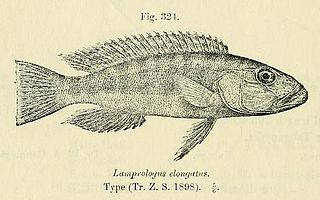
Lepidiolamprologus is a small genus of cichlids endemic to Lake Tanganyika in eastern Africa. It is closely related to Altolamprologus. and there is the possibility that a revision of the genus could see more species added.
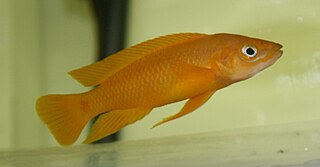
Neolamprologus leleupi is a species of cichlid endemic to Lake Tanganyika where it occurs throughout the lake. It is a recess-dweller, inhabiting cracks and crevices. It feeds on invertebrates living in the rich biocover of the substrate. This species reaches a length of 10 centimetres (3.9 in) TL. The color of this fish ranges from bright yellow to deep brown. Both color variations exist at each location where this species is found. This relatively small cichlid is a substrate spawner. It is easily confused with the very similar N. longior a fish also endemic to Lake Tanganyika. The specific name honours the Belgian entomologist Narcisse Leleup (1912-2001), who collected the type.

Grammatotria lemairii is a species of cichlid endemic to Lake Tanganyika in East Africa where it prefers areas with sandy substrates. This species can reach a length of 26 centimetres (10 in) TL. It is currently the only known member of its genus. The species is occasionally kept as an aquarium fish. The specific name honours Lieutenant Charles Lemaire (1863-1925) who was the leader of the Congo Free State Expedition, which collected specimens of fishes at Lake Tanganyika, including the type of G. lemairii.
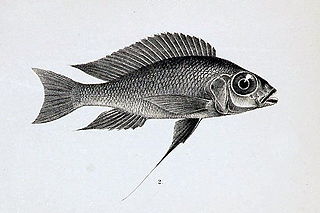
Cunningtonia longiventralis is a species of cichlid endemic to Lake Tanganyika in East Africa where it is found near rocky shores. It eats floating plankton. This species reaches a length of 14 centimetres (5.5 in) TL. It can also be found in the aquarium trade. As of 2011 it is the only known member of its genus. The generic name honours the British zoologist and anthropologist William Alfred Cunnington (1877-1958), the leader of the expedition to Lake Tanganyika during which type was collected.

The convict julie is a cichlid species in the subfamily Pseudocrenilabrinae family endemic to Lake Tanganyika. Hence it is found in Burundi, the Democratic Republic of the Congo, Tanzania, and Zambia. The fish is named after Charles Tate Regan.

Lamprologus lemairii is a species of cichlid endemic to Lake Tanganyika where it prefers to lurk by rocks or on the lake bed waiting for fish to prey on. This species can reach a length of 25 centimetres (9.8 in) TL. The specific name of this fish honours the leader of the Congo Free State expedition which collected the type, Lieutenant Charles Lemaire (1863-1925).

Lepidiolamprologus cunningtoni is a species of cichlid endemic to Lake Tanganyika where it prefers areas with sandy substrates in which it digs crater-shaped nests. This carnivorous species takes fish as prey. This species can reach a length of 29.1 centimetres (11.5 in) TL. This species inclusion in this genus has been questioned based upon its lacking many of the characteristics of its congeners. It can also be found in the aquarium trade. The specific name of this fish honours the British zoologist William Alfred Cunnington (1877-1958), who collected the type on an expedition to Lake Tanganyika.
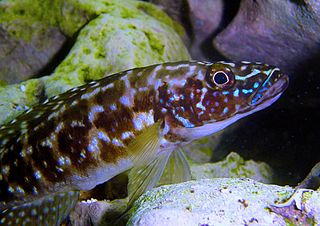
Lepidiolamprologus kendalli is a species of cichlid endemic to Lake Tanganyika preferring rocky areas. This carnivorous species preys upon fish. This species can reach a length of 18 centimetres (7.1 in) TL. It can also be found in the aquarium trade.

Limnotilapia dardennii, the latticed cichlid, is a species of cichlid endemic to Lake Tanganyika, where it prefers rocky areas near the coast. It may also be found in the aquarium trade. This species is currently the only known member of its genus.

Lepidiolamprologus boulengeri is a species of cichlid endemic to Lake Tanganyika where it is known from the Tanzanian coast in the northern part of the lake. Pairs of this species live together in their territory and the female lives in snail shells in a pit that they have dug in the sand. This species can reach a length of 6.2 centimetres (2.4 in) TL. This species can also be found in the aquarium trade.
Neolamprologus buescheri is a species of cichlid endemic to Lake Tanganyika. This species can reach a length of 8 centimetres (3.1 in) TL. It can also be found in the aquarium trade. The specific name of this cichlid honours the collector of its type, the German ichthyologist Heinz H. Büscher.
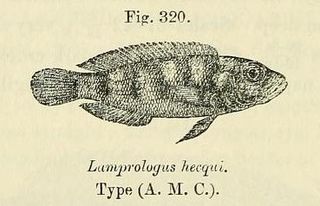
Lepidiolamprologus hecqui is a species of shell-living cichlid endemic to Lake Tanganyika. This species can reach a length of 8 centimetres (3.1 in) TL. This species can also be found in the aquarium trade.

Neolamprologus leloupi is a species of cichlid endemic to Lake Tanganyika. This species reaches a length of 6.1 centimetres (2.4 in) TL. It can also be found in the aquarium trade. The specific name honours the malacologist Eugène Leloup (1902-1981), chief of the Belgian Hydrobiological Mission to Lake Tanganyika in 1946–1947, the type being collected during this expedition.
Neolamprologus savoryi is a species of cichlid endemic to Lake Tanganyika. This species reaches a length of 8 centimetres (3.1 in) TL. It can also be found in the aquarium trade. The specific name of this cichlid honours Bryan Wyman Savory (1904-1988) who was the District Commissioner of Kigoma in the Tanganyika Territory during the Belgian Hydrobiological Mission to Lake Tanganyika of 1946–1947, this expedition collected the type.
Neolamprologus schreyeni is a species of cichlid endemic to Lake Tanganyika where it is only known from along the Burundi coast, inhabiting crevices. This species reaches a length of 5 centimetres (2.0 in) TL. The specific name honours Andre Schreyen, the nephew of and collaborator with the fish trader Pierre Brichard (1921-1990), who was the collector of the type.
Neolamprologus wauthioni is a species of cichlid endemic to Lake Tanganyika where it inhabits snail shells. This species reaches a length of 5.5 centimetres (2.2 in) TL. The specific name of this cichlid honours René Wauthion, a Provincial Commissioner in the Belgian Congo during the Belgian Hydrobiological Mission to Lake Tanganyika of 1946–1947, this expedition collected the type.
Plecodus straeleni is a species of cichlid fish that is endemic to Lake Tanganyika in East Africa. This species can reach a total length of 16 centimetres (6.3 in).

Xenochromis hecqui is a species of cichlid endemic to Lake Tanganyika in East Africa. It is mainly found at depths of 6–100 m (20–328 ft), but has been recorded somewhat deeper, even in waters virtually devoid of oxygen. This species is a scale eater, consuming the scales off of other fishes, but will also feed on copepods. It can reach a total length of up to 30 cm (12 in). Currently it is the only known member of its genus. The specific name honours the Belgian Lieutenant Célestin Hecq (1859-1910), a member of the Belgian colonial forces fighting the slave trade who collected the type of this species.














